What are the advantages of solar roofing in Arizona? Arizona, one of the sunniest states in the U.S., offers immense potential for harnessing solar power. Solar roofing, an innovative and aesthetic solution, is leading Arizona's transition to green energy. Taking full advantage of the state's abundant sunshine, it promises many benefits beyond environmental sustainability.
With its favorable geographical positioning and climate, solar roofing holds substantial promise for Arizonian homeowners and businesses. This article will delve into the multiple advantages of adopting solar roofing in Arizona, discussing aspects such as cost savings, environmental impact, increasing property value, and more.
Before exploring the benefits, it's essential to understand what solar roofing is. Solar roofs, often referred to as solar shingles or tiles, are roofing materials that incorporate solar photovoltaic (PV) technology. They capture sunlight and convert it into electricity for use in your home.
These innovative products blend the functionality of a traditional roof with the capability to generate renewable energy, thereby serving dual purposes - protecting your home and powering it.
Arizona is often referred to as the "sunniest state" in the U.S. With Phoenix, the state's capital, boasting an impressive 299 sunny days a year, the potential for harnessing solar power is tremendous.
The first and perhaps most significant advantage of solar roofing in Arizona lies in the state's abundant sunshine. Solar panels rely on sunlight to generate electricity, and more sunlight translates to higher energy production. The more energy your solar roof can produce, the less electricity you need to draw from the grid, leading to considerable savings on your utility bills.
A significant advantage of solar roofing is the potential for substantial cost savings. While the upfront costs of solar roofing can be higher than traditional roofing materials, the long-term savings typically more than offset the initial expenditure.
Solar roofs can significantly cut down on electricity bills in Arizona, where air conditioning usage is high due to the hot climate. Since solar panels can last up to 25-30 years, homeowners are looking at decades of reduced electricity costs.
Solar energy is a clean, renewable resource, unlike fossil fuels, which are finite and contribute to climate change. You significantly reduce your home's carbon footprint by installing a solar roof. Over its lifetime, a residential solar power system can offset the carbon dioxide equivalent of driving a car for 100,000 miles or more.
Furthermore, unlike other energy sources, solar energy doesn't require water to process, making it a great option for Arizona, where water resources can be scarce.
Homes equipped with solar power systems have been found to sell at a premium compared to homes without such systems. A study conducted by the Lawrence Berkeley National Laboratory concluded that homes with solar panels sell for more than those without. Given the sunny climate in Arizona, a solar roof can significantly increase the market value of your home.
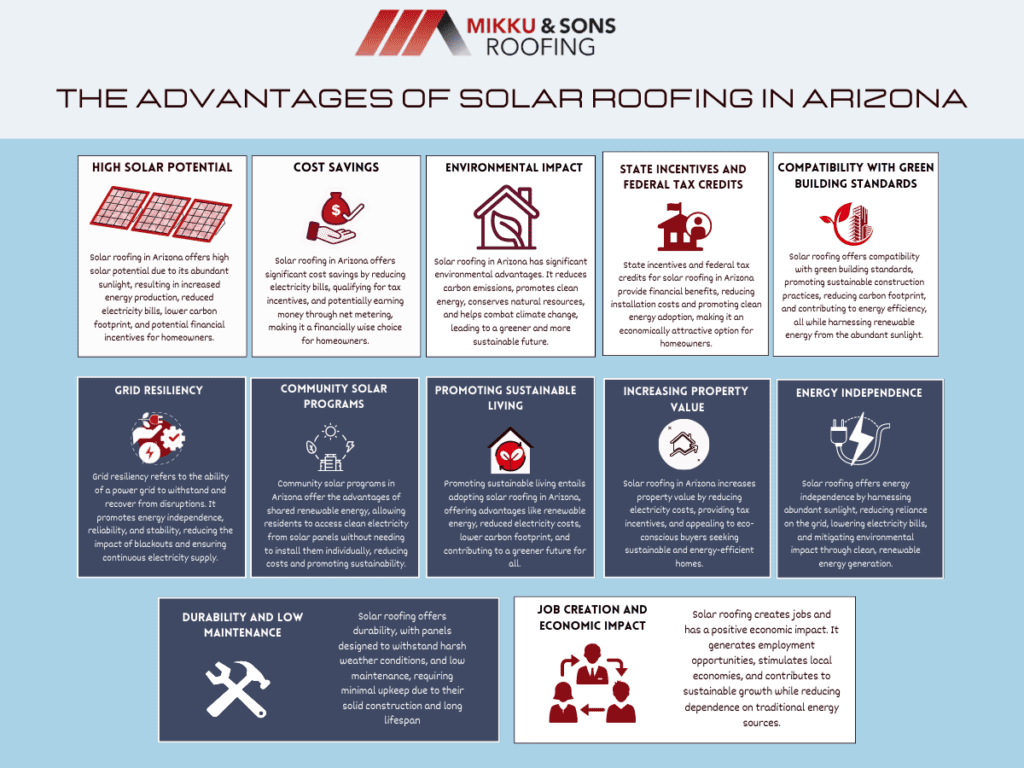
With a solar roofing system, you are less dependent on the grid. This autonomy can be particularly advantageous during power outages or periods of high electricity demand when utility companies often increase rates.
Additionally, Arizona's net metering policies allow homeowners to sell any excess electricity their solar system generates back to the grid. This setup can lead to further savings or even potential income, adding another financial incentive for solar power.
Solar roofs have proven to be incredibly durable and require minimal maintenance. They are designed to withstand harsh weather conditions, including the high temperatures and heavy monsoon rains that Arizona can experience. Most solar roofing systems come with lengthy warranties, often up to 25 years, providing homeowners with peace of mind.
Regular cleaning and an annual inspection are usually all that's needed to keep a solar roof in good condition. This low maintenance adds to the overall cost-effectiveness of the system over its lifespan.
Solar roofs, especially those paired with a battery storage system, contribute to grid resiliency. They can store excess power generated during the day for use during the night or cloudy periods.
In the event of a blackout or grid failure, homes with stored solar power can still have access to electricity. This feature can be especially beneficial in Arizona, where summer storms can sometimes disrupt the power supply.
Community solar programs offer an alternative for homeowners who may not have suitable roofs for solar installation or live in apartments. These programs allow multiple people to benefit from a single, shared solar array, which can be installed on a suitable site within the community. Arizona has several such programs, expanding the accessibility of solar power to more residents.
On a more personal level, installing a solar roof promotes a sustainable lifestyle. It allows homeowners to actively participate in the fight against climate change by reducing reliance on fossil fuels. It's a clear statement of environmental responsibility and commitment to the future of our planet.
Arizona offers several incentives for homeowners to switch to solar energy. These include property and sales tax exemptions, making the upfront cost of solar installation more affordable.
The Arizona Public Service (APS) and Tucson Electric Power (TEP) also provide incentives for customers who install solar power systems. Moreover, the federal government offers a significant solar Investment Tax Credit (ITC), which allows homeowners to deduct a portion of their solar costs from their taxes.
Solar roofs can help a building meet green building standards such as LEED (Leadership in Energy and Environmental Design). These certifications can enhance a property's value and appeal. In Arizona, where sustainable building practices are becoming more popular, a solar roof can significantly contribute to a building's green credentials.
The solar industry has also contributed positively to Arizona's economy. The rise in solar installations has increased job opportunities for solar installers, electricians, and manufacturers. According to the Solar Foundation, the solar industry has created thousands of jobs in Arizona, stimulating the local economy.
The advantages of solar roofing in Arizona are multifaceted, ranging from significant cost savings and environmental benefits to property value enhancement and energy independence.
With abundant sunshine, attractive incentives, and the potential for significant long-term savings, there's no better time than now for homeowners in Arizona to consider solar roofing as a viable, sustainable option for their homes.
Are you wondering what is the proper roof ventilation in the Arizona heat? Maintaining a comfortable home environment presents unique challenges in the breathtaking, arid expanse of Arizona, where temperatures routinely reach triple digits. Among them is a factor that often goes unnoticed: proper roof ventilation. It is a subject often overlooked in the broader discussion of building design and maintenance, yet, it carries immense significance.
By ensuring a properly ventilated roof, homeowners can reduce the strain on their air conditioning units, reduce energy costs, maintain the structural integrity of their houses, and enjoy a healthier living environment.
This article aims to shed light on the importance of proper roof ventilation in Arizona's scorching climate, exploring the science behind roof ventilation, its tangible benefits, and effective ventilation strategies for your home. Let’s start!
Before delving into the importance of roof ventilation in Arizona heat, it's necessary to understand what roof ventilation is and how it operates. Simply put, roof ventilation is a system that allows air to flow in and out of your attic space, ensuring that the air inside your home is neither too hot nor too cold, regardless of the weather outside.
The science behind roof ventilation is relatively simple. The sun heats up the roof, warming the air in your attic. If this warm air is not allowed to escape, it can radiate downward, raising the temperature of the living spaces below.
At the same time, cool air must be allowed to enter the attic to replace the hot air that has been expelled. This process creates a continual air exchange, keeping the attic's temperature more in line with the outside temperature, which is significantly cooler than the heated roof surface.

In the relentless heat of Arizona, where summer temperatures can soar past 100 degrees Fahrenheit, proper roof ventilation becomes more than just a matter of comfort; it's a necessity for several reasons:
In the scorching Arizona heat, attics can reach temperatures far exceeding the outdoor temperature. This heat buildup can then permeate downward into living areas, causing air conditioning systems to work harder and consume more energy.
By promoting the circulation of cooler air and expulsion of hot air, proper roof ventilation reduces the temperature in the attic, resulting in less strain on the air conditioning system, conservation of energy, and reduction of utility bills.
Prolonged, extreme heat exposure can cause significant damage to your roof. The roofing materials can deteriorate more quickly under these conditions, leading to leaks, damage, and potentially a premature need for roof replacement. The heat can also warp the house's structural elements over time.
A well-ventilated roof helps mitigate these risks by reducing the temperatures to which these components are subjected.
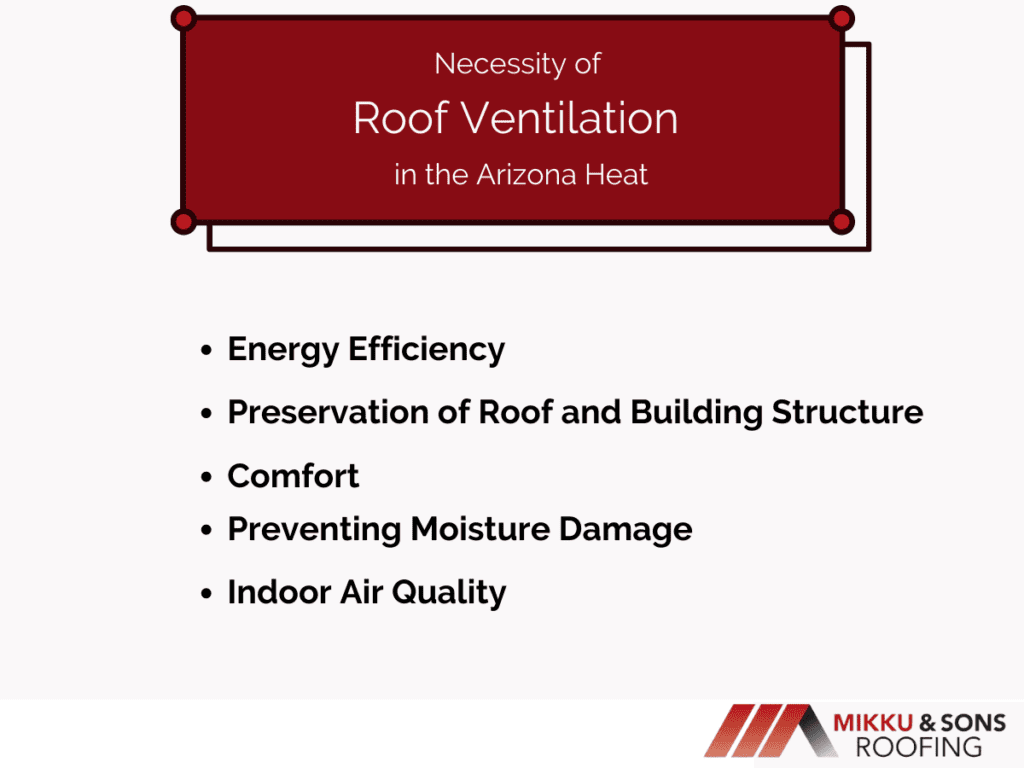
Comfort
Inadequate ventilation can turn your attic into an oven, allowing heat to permeate down into your living space, making your home uncomfortably warm. Good ventilation helps to keep your home cooler and more comfortable during the Arizona summer.
While Arizona is known for its dry heat, it still experiences periods of high humidity, rain, and even snow in some regions. During cooler months, warm air from heating systems can rise into the attic, where it can condense on colder surfaces, leading to moisture accumulation.
Over time, this can lead to mold growth, wood rot, and other moisture-related problems. Proper ventilation helps maintain a more consistent attic temperature, reducing the potential for condensation.
Improperly ventilated attics can become hotspots for mold and mildew growth, particularly if there are leaks or condensation issues. These spores can infiltrate your home's living spaces, triggering allergies, asthma, and other respiratory issues.
Proper roof ventilation can help improve your home's overall air quality by maintaining a cooler, drier attic environment. Thus, proper roof ventilation is essential for maintaining a comfortable, healthy, and energy-efficient home in the Arizona heat. It is a critical aspect of home design and maintenance in hot climates and one that warrants careful consideration.
Roof ventilation methods primarily focus on maintaining a continuous flow of air in the attic, removing hot air, and bringing in cooler air. The various methods employed each have their own strengths and specific uses, and often, a combination of methods is used to achieve optimal ventilation.
Here are some common roof ventilation methods:
Choosing the best method or combination of methods for ventilating a roof depends on a variety of factors, including your roof's design and structure, local climate, and your specific needs. It is recommended to consult with a roofing or ventilation expert to determine the most effective ventilation system for your home.
While installing or improving your roof's ventilation system may involve an initial investment, the long-term benefits in the form of lower utility bills, reduced maintenance costs, and a healthier living environment make it a wise decision, particularly in the extreme heat of Arizona.
Considering your home's specific needs and characteristics, working with a professional roofer who can evaluate your current ventilation system, identify any issues, and provide the most effective solutions is highly recommended.
Remember, a well-ventilated roof protects the house from the searing Arizona heat, enhances the roof's longevity, and contributes to a healthier, more comfortable indoor living environment. It is a fundamental aspect of home maintenance in Arizona that deserves careful attention and timely action.
The roof is one of the most crucial components of both residential and commercial buildings. It's an essential utility that safeguards your family, possessions, and you from the potentially damaging impacts of the weather. Roofs, however, can also significantly impact your home's aesthetics.
So how important should you consider roof aesthetics in your home? The truth is that it can be crucial, especially if you want to raise the value of your house. An aesthetic roof may increase your home's resale value and attract more potential buyers, but quality and durability always win out.
Read this article to learn more about the significance of taking roof aesthetics into account. We’ll talk about the following topics:
Apart from the fact that your roof protects you against many elemental dangers and environmental hazards, the roof aesthetics also matter because they are prominent and permanent.
The majority of property owners want their buildings to look good and to be presentable at all times. It is important for homeowners to have curb appeal, and it is important for businesses to have a good reputation. If you're the kind of homeowner who takes great care in your house and neighborhood, choosing an aesthetic roof will bring you a lot of satisfaction.
If you choose an aesthetically pleasing roof for your house, you are giving it a facelift by injecting some style into it. On the other hand, a dated or worn-out roof might make your house appear old and neglected, which will result in lesser bids from prospective buyers. Aesthetics are important, and making an investment in your roof's appearance can pay off in the long run by raising the value of your house when you decide to sell it.
Not everything hinges on having fancy roofing materials and elaborate style. There are also other factors to take into mind if you want your roof to be regarded as aesthetic. These are a few roofing aesthetic considerations:
First of all, you have to make sure that the roof of your choice blends in with the surroundings. For instance, the roof of an old-style house should be compatible. Commercial buildings that are really modern should have intricate structures that match their architecture. Keeping the design consistent helps to enhance the property's overall appeal.
For the roof to truly have curb appeal, it must look beautiful from every angle and perspective. If the roof installation is done properly, there won't be any unsightly areas or other problems. The material and style of your roof should complement the architecture and design of your home to create a cohesive and attractive look.
Choose the appropriate hues and patterns for your roof. There are many possibilities available for materials like asphalt, metal, and clay roof tiles, so it's simple to pick something that exactly meets your needs. A beautiful roof that does not complement the color and texture of the house can really be just as bad.
Items above the hood are important, but they are just as important as things underneath. Your roof's underlayment needs to be as sturdy as the protective metal or asphalt shingles. When the roof is functioning properly and can last long-term, you have what you need to increase the value of the property.
As mentioned, aesthetic roofs are wonderful, but they must also be reliable and functional. If the roof is flimsy, it will seriously do more harm than good to your property. In fact, the components above the hood are equally as essential as those underneath. Thus, your roof should resist all kinds of weather like hail, rain, snow, and wind storms.
For instance, the roof should protect both the interior and exterior of the building. It should have adequate drainage without any holes or other weak spots that could let water leak later. A high-quality roof will reliably protect your property for many years.
Additionally, your roof should be strong enough to stop internal and external air leakage. A strong roof will reflect the sun's rays, maintaining a fairly constant temperature beneath its surface. These considerations will ensure that your HVAC system doesn't have to work too hard or use a lot of energy to keep things comfortable.
The material and style of your roof can impact its overall appearance and resale value. For instance, a sleek and modern metal roof can add a contemporary touch to your home, while a classic shingle roof can create a more traditional look. With that, here are some of our recommendations to elevate the aesthetic of your roof without sacrificing its quality.
Clay or concrete roof tiles can elevate the aesthetics of your old-style home. If you have a Mediterranean or Spanish-style house, clay or concrete tiles will look best on your roof. Both materials are solid and suitable for hot temperatures, enduring strong winds, and heavy rains. However, due to the weight of these materials, a structure with stronger support and foundation is needed to install them.
Due to its simple construction, durability, and variety of shapes and colors, metal is a common building material. Modern houses, log cabins, and bungalows look aesthetically pleasing with metal roofs. It can also shield homes from fire as well as torrential rain and intense sunlight. Metal roofs can last for more than ten years if they receive the necessary care. They are economical because of their durability.
Asphalt, fiberglass, and mineral granules comprise asphalt shingles, also known as composite shingles. They are regarded as fashionable and available in various designs and hues. Asphalt shingles complement many different architectural types as well as classic suburban homes.
Because it is simple to install and reasonably priced, asphalt is a common choice for roofing materials. Also, the lifespan of asphalt shingles can range from 12 to 30 years or even longer, depending on their quality and how well you maintain them.
Another popular roofing material that is admired for its beauty and toughness is slate. Slate is an organic material made out of rock, making it last longer than other roofing materials. It is a top option for homeowners who only want the best materials for their roofs. It is fire-resistant, waterproof, and requires minimal maintenance. It can last for up to a century. However, it is indeed one of the most expensive roofing materials and one of the hardest to install.
Insulated Metal Panels complement any modern home or architectural style because they are available in various colors and designs. Homeowners choose this type of roofing material when they want high-end metal roofing that serves both functionality and aesthetics.
While it provides an aesthetically pleasing style to your house, it can also aid in regulating the temperature within your home and result in energy savings. Insulated roofing panels are made of multiple layers, with a polyurethane or polyisocyanurate core sandwiched between two metal sheets, giving them strength, fire resistance, and weather resistance.
If you decide to install an aesthetically pleasing roof, your home will appear better than ever, especially to prospective buyers if you ever plan to sell it.
One of your home's most noticeable characteristics, the roof is important in making a strong first impression. Your home can stand out in a crowded real estate market and attract more potential buyers with a lovely, well-maintained roof.
However, while selecting roofing materials and designs, it's crucial to consider durability, energy efficiency, and maintenance requirements. By investing in high-quality roofing materials, you can improve the appearance and durability of your roof and the value of your home. Ultimately, it is not worthwhile to forgo functionality in favor of aesthetic looks.
If you have an old roof and are considering replacing it, you are not alone. A worn-out roof must be replaced as it is one of the essential components of your house. In addition to giving your house a more excellent and newer appearance, a new roof has real advantages like an increased home value.
This article will discuss how your roof affects your home’s value and whether replacing it is a decent return on investment. We’ll discuss the following:
Most homeowners are worried about their roofs protecting all the expensive items underneath them. Even if the rest of your house needs to be updated and worth a lot, upgrading a new roof can significantly raise the value of your house. For instance, if something goes wrong with your roof, replacing it can be one of the most expensive upgrades you can do. Therefore, ensuring that part of your home looks great and lasts a long time adds much value to your home.
Furthermore, if you are remodeling your home to make it stand out in the market and add to its value for insurance or resale purposes, the roof should be a top priority. It is what the home inspectors immediately check when they visit a house since a roof's condition directly affects a home's value. A new or updated roof provides a great return on investment since it significantly improves a home's overall health.
For starters, a roof nearing the end of its lifespan or leaking will definitely decrease your home value. Even if a house has a lovely structure and a sturdy foundation, nobody will notice these things if the roof is deteriorating and coming off. It could be a significant problem if you're thinking about selling.
As mentioned, one of the most essential elements in evaluating the overall value of your property is the condition of your roof.
Although a roof replacement can be expensive, it might be worthwhile considering the potential harm your old roof could do to your selling. There could be fewer offers, a longer sale process, and a reduced offer price.
A new roof can increase the value of a home, but you would see a partial return on investment. The overall housing market impacts the value of every home improvement.
Additional elements should also be considered, including the state of your roof, the local housing market, and the type of replacement roof you select. Your best choice for understanding the market circumstances you are dealing with is to consult local appraisers and professional real estate brokers.
However, it is essential to note that even if you don't see a total return on your investment, you can increase your likelihood of getting your total asking price, shorten the time your house is on the market, and facilitate smoother negotiations with buyers. According to The National Association of the Remodeling Industry (NARI) report, they have found that new roofs provide a 109 percent return, which means you could still make a profit on your new roof.
A new roof will generally yield a return on investment of 60-68 percent, depending on the state of your previous roof and the quality of the materials used. You won't get a 100 percent ROI, but that doesn't mean you shouldn't consider it.
Generally, your home's outside will look better with a new roof, making it easier to sell. A quicker sale can result in cash gains depending on your goals and objectives.
With that, here are a few of the most critical considerations for considering a new roof before putting your house on the market.
A local roofing contractor can examine the roof's condition and inform you of its precise requirements. In many circumstances, your contractor can repair them instead of completely replacing them while guaranteeing their work.
You may significantly reduce potential concerns prospective purchasers may have by displaying the inspection report and the contractor's warranty.
A new roof can be expensive to purchase, and there is no assurance that you can recoup your costs when you sell the house. Finding a contractor who employs quality installation services, the appropriate materials, and reasonable pricing is the key.
This can result in products of exceptional quality at a low price, thus enhancing the cost-to-value ratio.
You should match the material of your existing roof if you are merely replacing shingles or a portion of the roof. On the other hand, you have more choices if you're rebuilding the roof entirely.
The money you get back for your new roof may depend on your chosen shingles. Generally, a new roof must be constructed with roofing materials that are at least as good as the old ones, if not better.
Whether investing in a new roof is a wise decision largely depends on your unique situation. While it may seem like an expensive renovation up front, the return on investment can be more than you anticipate.
However, investing in new high-quality roofing might not necessarily result in the rise in home value you hope for. It would be best to consider several important factors, such as buying preferences, market conditions, and roof conditions.
Even though you may not predict precisely how much a new roof will increase your home's value, it's crucial to consider the other benefits of upgrading your roof, such as improving its overall health, enhancing its appearance, and safeguarding you from danger.
A roof replacement is a significant investment that not only enhances the appearance of your home but also safeguards its structural integrity. Proper preparation is essential to ensure a smooth and successful project.
This comprehensive guide will walk you through the steps to preparing your home for a roof replacement, from choosing the right contractor and materials to taking care of your home's interior and exterior. We’ll talk about the following topics:
The first step in preparing for a roof replacement is finding a reputable, experienced roofing contractor. A reliable contractor will ensure the job is done professionally, within budget, and on time.
Conduct thorough research by:
By following these steps, you can make an informed decision and choose the right roofing contractor for your roof replacement project. This will ultimately help you achieve a successful outcome and ensure the longevity and durability of your new roof.
Before starting a roof replacement, obtaining the proper permits and documentation is crucial to ensure the project adheres to local building codes and regulations. This process helps to maintain safety and avoid potential legal issues or fines.
Here are some steps to ensure you have the necessary permits and documentation for your roof replacement project:
By ensuring proper permits and documentation are in place before starting a roof replacement, you can protect yourself from potential legal issues and fines and ensure your new roof adheres to local building codes and safety regulations.
Selecting the appropriate roofing material is an important decision when planning a roof replacement. Factors to consider include climate, aesthetics, durability, cost, and energy efficiency.
Here are some common roofing materials and their characteristics to help you make an informed decision:
The most popular roofing material, asphalt shingles, are affordable, easy to install, and come in a variety of colors and styles. They have an average lifespan of 20-30 years and provide adequate protection against various weather conditions. However, they are not the most eco-friendly option and may not be suitable for extreme climates.
Metal roofs are durable, lightweight, and low maintenance. They can last up to 50 years and protect against extreme weather conditions, including wind, hail, and fire. Metal roofing is energy-efficient, reflecting sunlight to reduce cooling costs. However, it can be more expensive than asphalt shingles and may not suit all architectural styles.
Tiles of clay or concrete are heavy, durable, and long-lasting (up to 50-100 years). They provide excellent protection against fire, wind, and hail. These tiles are energy-efficient, help maintain indoor temperature, and come in various colors and styles. However, they are more expensive than other materials and may require additional structural support due to their weight.
Wood roofing materials are natural and attractive, suitable for traditional or rustic homes. They typically last 25-30 years, depending on the type of wood and proper maintenance. However, they are more susceptible to fire, rot, and insects and may require frequent maintenance. Some areas may have restrictions on wood roofing due to fire concerns.
Slate is a premium roofing material with a distinctive appearance, often found in historic or high-end homes. It is extremely durable, with a lifespan of up to 100 years. Slate provides excellent fire and weather resistance but is heavy and expensive. It also requires professional installation and may need additional structural support.
Synthetic materials, such as rubber, plastic, or composite roofing, are designed to mimic the appearance of natural materials like wood or slate. They are lightweight, durable, and low-maintenance, with lifespans ranging from 30 to 50 years. However, they can be more expensive than traditional materials, and their long-term performance may vary.
When selecting a roofing material, consider your home's architectural style, local building codes, and climate. Work with a knowledgeable contractor to discuss the advantages and disadvantages of each material and choose the one that best suits your needs and preferences. Selecting the appropriate roofing material ensures your roof replacement is a long-lasting and valuable investment.
Before starting a roof replacement project, it's essential to prepare the exterior of your home to protect your property and ensure a smooth and efficient process.
Here are some steps to follow:
By taking the time to prepare the exterior of your home before a roof replacement, you can minimize potential damage, make the process more efficient, and ensure a safer environment for the roofing crew.
Preparing the interior of your home before a roof replacement is essential for minimizing disruptions and potential damage caused by the construction process. Here are some steps to follow:
By preparing the interior of your home before a roof replacement, you can minimize disruptions, protect your belongings, and maintain a safe and comfortable environment for your household.
Preparing for potential challenges before a roof replacement is essential to minimize disruptions and ensure a smooth process. Here are some common challenges and how to prepare for them:
Roofing projects can be delayed or interrupted by adverse weather conditions, such as rain, snow, or high winds. Monitor the weather forecast leading up to the project and discuss contingency plans with your contractor. Be prepared for potential delays and have a flexible schedule to accommodate any changes.
Once the old roofing materials are removed, there may be hidden damage to the roof deck, rafters, or other structural elements. This can lead to additional repairs and increased costs. Discuss this possibility with your contractor and ensure you have a contingency budget for unforeseen expenses.
Roofing materials can sometimes be subject to delays or shortages, which can impact the project's timeline. Communicate with your contractor to ensure materials are ordered and delivered on time. Be prepared for possible delays and have a flexible schedule.
Roof replacement can be noisy and disruptive for both you and your neighbors. Prepare for the noise by finding alternative workspaces or quiet areas in your home. Inform your neighbors about the project to minimize potential conflicts.
Roofing crews need space to park their vehicles, store materials and set up equipment. Discuss access and parking requirements with your contractor and make necessary arrangements, such as relocating your vehicles or coordinating with neighbors.
As mentioned above, you must ensure all necessary permits are obtained and inspections scheduled before starting the project. Failure to comply with local building codes and regulations can lead to delays, fines, or legal issues.
Roofing work can be hazardous, both for the crew and your property. Ensure your contractor follows proper safety protocols and takes measures to protect your home and landscaping.
Maintain open lines of communication with your contractor throughout the project. This will help address any issues that arise promptly and minimize potential misunderstandings or conflicts.
Preparing for a roof replacement is crucial in ensuring a smooth and successful project. From selecting the right roofing contractor to protecting your home's interior and exterior, careful planning and preparation can significantly impact the overall experience.
By addressing potential challenges and taking the steps above, you can ensure that your roof replacement project is a positive and stress-free experience. A well-prepared homeowner can enjoy the peace of mind that knowing their home is protected with a durable, high-quality new roof that will last for years.
Do you want to work as a roofer in Arizona? The building business in Arizona is booming; therefore, many jobs are available for roofers in the Grand Canyon State. The roofing employment market may be competitive whether you're just starting out or have years of experience under your belt.
The purpose of this blog is to guide you on how to find a roofing job in Arizona and help you get started in the roofing industry. We will go through everything you need to know to get the ideal roofing project, from finding reliable local contractors to making connections with other experts in the field. Let's dive in right now!

If you’re looking for a job in the roofing industry in Arizona, you’ve come to the right place. With plentiful resources for contractors and job seekers, Arizona is a great place to start your search for roofing jobs. From Phoenix to Flagstaff, there are plenty of opportunities to gain experience and make a living in the roofing industry.
It is crucial to be well-prepared for the job search. Ensure a resume ready to go, and be sure to list any relevant experience you have in the roofing field. Utilize online job boards to search for roofing jobs in your area.
LinkedIn, Indeed, and Craigslist are three popular options. Additionally, consider networking with roofing contractors in Arizona. Ask them if they are hiring or if they can refer you to someone who is.
There are several resources available to help you find roofing jobs in Arizona. Consider joining a trade organization or professional association such as the Arizona Roofing Contractors Association (ARCA). ARCA provides its members with a job board and access to a network of other roofing professionals.
You can also join local clubs, such as the National Roofing Contractors Association of Arizona, to make connections and stay up-to-date on the latest industry news.
In addition to the resources above, there are several other avenues to explore when looking for roofing jobs in Arizona. Reach out to local schools and businesses, as they may be looking for contractors to work on their roofs. You can also attend job fair trade shows to meet potential employers and learn more about the industry. Finally, consider advertising your services in newspapers and online to get the word out.
Choosing a reliable roofing contractor in Arizona can be challenging, but it’s crucial if you want your roof to survive for years. Choose the best roofing contractor for your house by taking your time and doing some research. If you need a roofer in Arizona, read below for some tips on how to get the best one.
These tips can help you find a good roofer in Arizona. Take your time and research to find an experienced contractor that will do a good job on your roof.
Roofing- is the practice of installing or repairing roofs on houses and other buildings. It is a specialized trade that requires knowledge and skill to complete. Roofers are responsible for installing, repairing, and maintaining roofs. They must be knowledgeable about construction materials, tools, and safety procedures. Roofers must also be able to work in all kinds of weather conditions, as well as in confined spaces.

Arizona is known for its hot, dry climate, making it a good place for roofing jobs. The state is also known for its diverse landscape, including desert and mountain regions. Roofing jobs in Arizona provide good benefits to those who take them on. Here are a few key benefits of doing roofing jobs in Arizona.
One of the great benefits of roofing jobs in Arizona is the wide variety of materials available.You can find everything from traditional asphalt shingles to modern metal options. It gives you multiple choices when finding the perfect roofing material for your job.
Arizona is known for its high-quality craftsmanship when it comes to roofing jobs. Roofers in the state have access to the latest technology and materials, allowing them to complete the job quickly and efficiently. It ensures that your roof will last for years to come.
Roofing jobs in Arizona are often more affordable than in other states due to the competitive nature of the market, as well as the availability of materials. In addition, roofers often offer discounts for large jobs or customers who purchase their materials in bulk.
Roofers in Arizona are typically highly professional and experienced. They understand the importance of providing quality work and customer service. It ensures that you get the best possible results from your roofing job.
Roofers in Arizona are required to follow all safety regulations and guidelines. It ensures that the job is correct and safe. This also helps to ensure that your roof is free from potential hazards that could result in damage or injury.
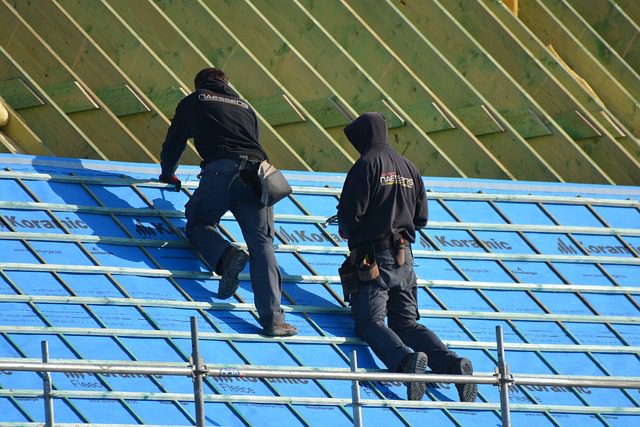
Roofing jobs can be very complex and require a lot of preparation. Whether you are a professional roofer or a homeowner looking to repair or replace your roof, it's important to make sure you have the necessary materials and tools to get the job done right. Here are some tips for preparing for a roofing job.
Before starting a roofing job, do some research. Look into the type of roof you have, the materials you need, and the tools and safety gear required. Also, consider the weather and terrain when preparing this job.
Knowing what the job will entail, it's time to gather the necessary materials. These include the roofing materials, such as shingles, nails, and sealants, as well as any other necessary supplies, such as ladders, buckets, and safety gear.
Before beginning the job, ensure the area is cleaned and cleared of debris and debris. These include removing any existing shingles, trimming trees, and removing any other obstacles that could interfere with the job.
Once the area is cleaned and cleared, it's time to inspect the roof. Look for any signs of damage, such as missing shingles or loose nails, and make any necessary repairs.
When working on a roof, it is required to use the proper safety gear. Ensure to use a harness and wear a hard hat, protective eyewear, and gloves.
When you have all the materials and safety gear, it's time to set up the equipment. These include setting up ladders, scaffolding, and other tools and equipment needed to complete the job.
Finally, it is best to check the weather before beginning the job. If the weather is too windy, rainy, or otherwise hazardous, wait until the conditions are more favorable.
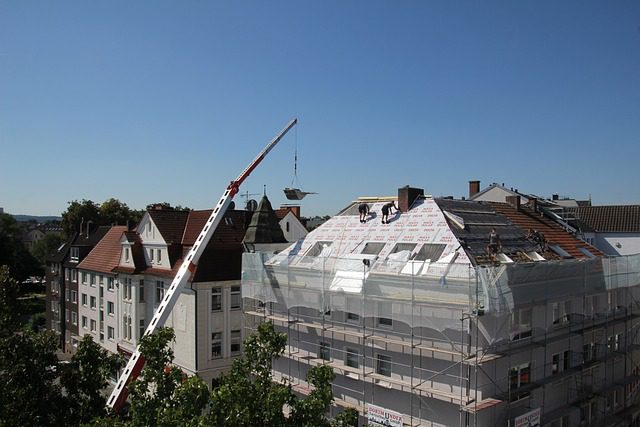
Experiencing the warmer weather and longer days in Arizona, roofing job opportunities are plentiful. Whether you’re looking for a full-time job or a part-time gig, there are roofing job opportunities to check in the Grand Canyon state.
But how do you go about evaluating these job opportunities? Here are some tips for evaluating roofing job opportunities in Arizona:
Before committing yourself to any roofing job, it’s important to do your due diligence and research the employer. Look up their online reviews, ask around, and see if anyone has previously worked with them, and find out what their reputation is. It’s also important to make sure they are licensed and insured.
Once you’ve narrowed your list of potential employers, check the job description. Be sure to pay special attention to the duties and responsibilities, as well as the required skills and qualifications. It is a great way to make sure the job is a good fit for you.
Every job should come with some benefits, like health insurance, vacation time, or retirement benefits. So, check for these and make sure the job you’re considering offers a competitive package.
Location is also an important factor to consider when evaluating roofing job opportunities in Arizona. When looking for a full-time or part-time job, you may want to consider the location of the job to determine if it is close to your home.
Last but not least, you should consider the pay. Compare the salary offered by the other employers you have chosen and make sure you’re getting a competitive wage.
By following these tips, you can evaluate roofing job opportunities in Arizona and find a job that will fit you. Good luck!
Finding a roofing job in Arizona can be an opportunity for anyone interested in the roofing trade. It is better to be prepared for the job search by gaining experience, obtaining certifications, and researching employers. There are many ways to find roofing jobs in Arizona, including networking, online job sites, and trade magazines. Finally, evaluate job opportunities before applying. By following these steps, you can find a roofing job in Arizona that is right for you.
Hello there! Are you a homeowner in Phoenix, Arizona? If so, then you may have a porch roof that needs some attention. Porch roofs are a great addition to any home, providing a cozy outdoor space for relaxation and entertainment.
However, like any other part of your house, porch roofs need proper maintenance and care to stay in top shape. One important aspect of porch roof maintenance is ventilation. In this article, we will explore whether porch roofs need to be vented in Phoenix Arizona, and discuss whether it is necessary or not. So, let's dive in!
Before we delve into the topic of porch roof ventilation, let's first understand what porch roofs are. Porch roofs are an extension of the main roof that covers a porch or patio area. They come in various shapes and sizes, from simple flat roofs to more complex gable or hip roofs. Porch roofs can be attached to the front, side, or back of a house, and are often supported by columns or pillars.
The purpose of a porch roof is to provide shade and shelter to the outdoor space, making it a comfortable area to sit and relax in. They also add aesthetic value to the home and can increase its curb appeal. So, if you have a porch or patio area in your home, chances are you have a porch roof too.
The answer is YES! Like any other part of your home, porch roofs require proper ventilation to maintain health and functionality.
Without proper ventilation, your porch roof can suffer from a range of issues, such as moisture buildup, mold growth, and premature aging. These problems can compromise the structural integrity of your porch roof and compromise the safety and comfort of your outdoor living space. And let's face it, nobody wants a moldy and old-looking porch roof, right?
Good ventilation helps to regulate the temperature and moisture levels in your porch roof, preventing damage and ensuring that it stays in good condition for years to come. So, if you want to keep your porch roof looking and functioning its best, make sure to give it the ventilation it needs.
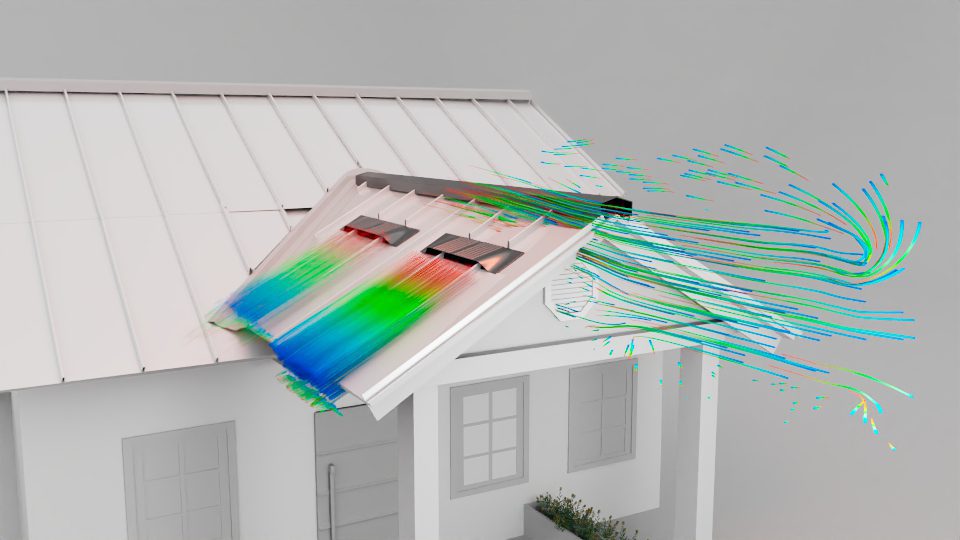
Do you know what's cooler than a cool roof? A well-ventilated roof! That's right, roof ventilation is not just a fancy term, it's actually crucial for the health and longevity of your roof.
Roof ventilation is essential to maintain the health and longevity of your roof. Proper ventilation helps to regulate the temperature and moisture levels in your attic, preventing damage to your roof and the rest of your home.
Here's why:
So, make sure to give your roof some love by paying attention to its ventilation needs, including your porch roof!
Okay, so we've established that porch roofs need proper ventilation to stay healthy and functional. But are there any instances where a porch roof can do without ventilation? The answer is yes, but these situations are few and far between.
In general, most porch roofs require ventilation to prevent moisture buildup and damage, but there are some instances where ventilation may not be necessary.

Shed roofs are single-sloping roofs that are often used for porches, patios, or outdoor storage areas. Since they have only one slope, they don't require any ridge or soffit vents. However, installing a gable vent at the top of the roof can still help improve airflow and reduce moisture buildup.
Gable roofs are the most common type of porch roof, with two slopes that meet at a ridge. These roofs require ventilation to prevent moisture buildup and damage, and homeowners can install ridge vents or gable vents to achieve proper airflow.
Flat roofs are another type of porch roof that may not require ventilation. These roofs are typically made of concrete, metal, or rubber-like material, and often feature a slight slope for water runoff. Since they don't have any ridges or slopes, ventilation may not be necessary. However, if the flat roof is attached to the main roof, proper ventilation is required.

Screened-in porches are another type of porch that may not require ventilation. Since they are enclosed, the screens can provide natural ventilation, and installing additional vents may not be necessary. However, if the porch is not screened, proper ventilation is still required to prevent moisture buildup.
In some cases, ventilation may not be necessary if the porch roof is in a dry climate or if the roof is not exposed to direct sunlight. Additionally, if the porch is used only occasionally and doesn't have any electrical or HVAC equipment, ventilation may not be necessary.
Remember, a healthy porch roof is a happy porch roof, and a happy porch roof makes for a happy homeowner. So, make sure to give your porch roof the love and care it deserves!
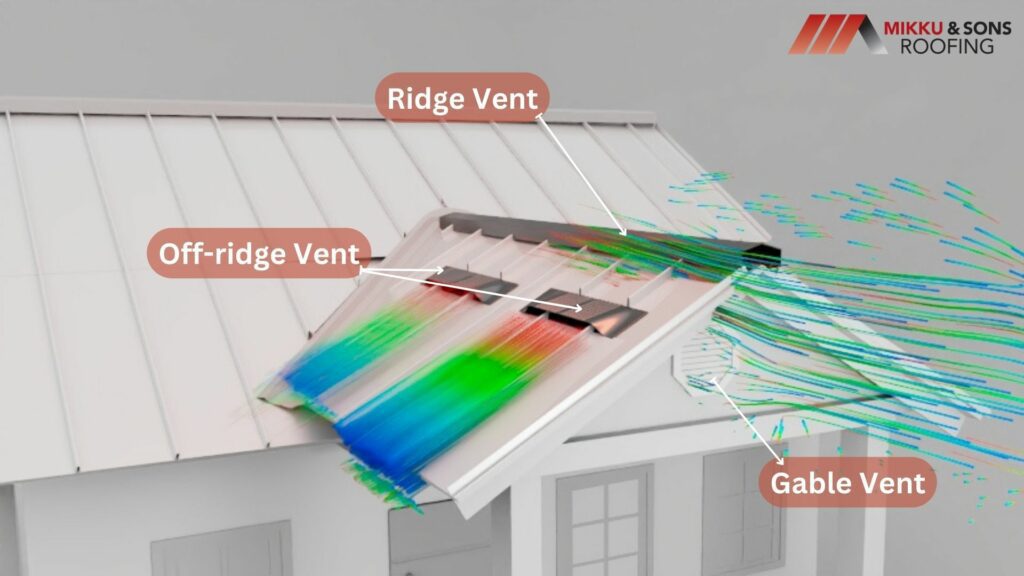
When it comes to porch roof ventilation, there are several types of systems that can be installed. Here are a few of the most common options:
Ultimately, the type of ventilation system you choose will depend on the specific needs of your porch roof and your budget. But regardless of which system you choose, proper ventilation is key to maintaining the health and longevity of your porch roof.
So, go ahead and get creative with your ventilation options! Whether you opt for a classic ridge vent or a high-tech solar-powered fan, your porch roof will thank you for the fresh air and healthy environment.
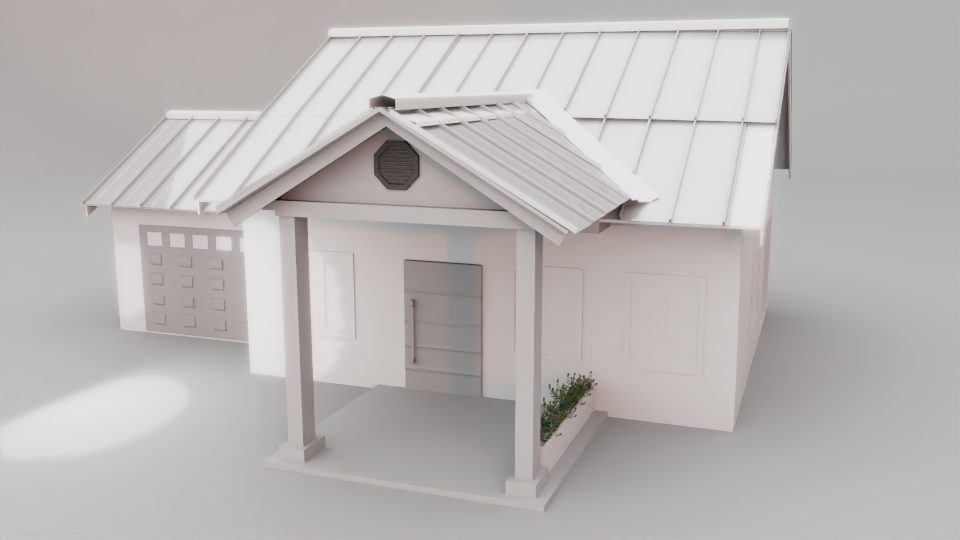
When connecting a porch roof to another type of roof, it's important to consider the ventilation requirements for both roofs. This may require installing additional vents or modifying existing ventilation systems to ensure proper airflow between the two roofs. Proper ventilation is essential to prevent moisture buildup and damage to the roof.
By ensuring proper ventilation when connecting a porch roof to another type of roof, you can prevent moisture buildup and damage to the roof, ensuring a longer lifespan for your porch roof.
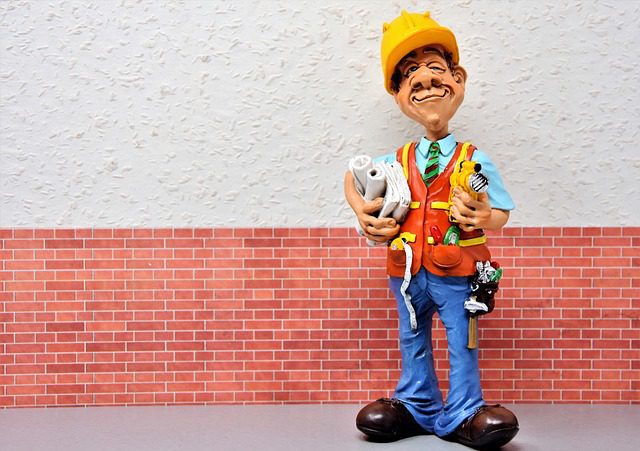
When it comes to porch roof ventilation in Phoenix, Arizona, there are specific laws and regulations that homeowners and contractors must follow. These laws are in place to ensure that the roof is structurally sound and that it provides proper ventilation to prevent moisture buildup and other types of damage.
The City of Phoenix has a roofing code that outlines the specific requirements for roof ventilation. The code stipulates that a minimum of 1/150th of the attic area must be ventilated, with a balanced distribution of vents between intake and exhaust vents.
In addition to the roofing code, there may be other laws and regulations that govern porch roof ventilation, depending on the location and type of property. For example, historic buildings may have additional requirements to preserve the integrity of the structure.
If a porch roof is found to be non-compliant with the ventilation requirements set out in the roofing code or other laws and regulations, the homeowner or contractor may be subject to fines or other penalties. In addition, failure to comply with ventilation requirements can lead to roof damage, which can be costly to repair.
Compliance with porch roof ventilation requirements is essential to ensure the safety and longevity of the roof, as well as the health of the occupants of the building. Proper ventilation prevents moisture buildup, which can lead to mold and mildew growth, rot, and other types of damage that can compromise the structural integrity of the roof.
Proper ventilation is essential for porch roofs in Phoenix, Arizona. Without adequate ventilation, the roof can be susceptible to damage caused by moisture buildup, including mold and mildew growth, rot, and other types of damage that can compromise the structural integrity of the roof.
Homeowners and contractors must comply with the specific requirements set out in the roofing code and other laws and regulations to ensure that the porch roof is structurally sound, and provides proper ventilation.
In addition, proper ventilation is essential to ensure the safety and health of the occupants of the building and this way, homeowners can ensure that their roof is protected from damage, and their property remains safe and secure.
Picture this: you're sipping a cup of coffee in your living room as the rain gently taps on your roof above. Suddenly, you hear a loud crash from above, and then water starts pouring through the ceiling.
You take a look up and notice that your roof has finally caved in. Yikes! Now you have to decide whether to replace your aging roof with clay tiles or with something more up-to-date, like concrete. Yes, it's a difficult concrete vs clay tile roof choice, but have no fear!
We're here to help you make a smart choice that will not only protect your home but also make it look better from the exterior. If you're trying to decide between a clay roof and a concrete roof, this essay can help you make an informed decision.

Do you find yourself drawn to the traditional beauty of a tiled roof for your home? If that's the case, you should look into purchasing clay tiles for your roof.
These tiles have been in use for centuries, giving them a rich heritage that dates from ancient times. Homeowners love clay tiles for their durability, variety of colors, and one-of-a-kind appearance.
So, what exactly are clay tiles, and why are they so popular?
They are made from natural clay, shaped, and burned at high temperatures to provide a strong and long-lasting roofing material. First, the clay is extracted from the ground, and then it is processed to eliminate any unwanted particles, like rocks or sticks.
After that, it gets combined with water and other ingredients to form a clay that can be molded. Once the mixture is ready, it is shaped into the tile's final form and set aside to dry.
After being shaped, the clay tiles are burned at high temperatures to make a tough and long-lasting roofing material. The clay tiles' signature red or orange hue comes from the firing process, which also renders them weatherproof.
Clay roof tiles can be found in a wide spectrum of colors, from the more classic red and orange to the more contemporary green, blue, and gray. The tiles' final color is affected by numerous variables, including the clay they were made from and the temperature of the firing process.
Clay tiles can also be found in a number of different forms and styles, from the classic S-shaped tile to the more contemporary flat or curved tile. By offering such a wide selection of sizes, shapes, and designs, tile companies give homeowners more opportunities to improve the aesthetic value of their homes.
Clay roof tiles have a strong reputation for lasting for many years. If properly cared for, they have a lifespan of 100 years or more, making them a wise choice for homes in need of a durable roofing material.
Clay tiles are fireproof, windproof, and watertight, making them a great roofing material for residences in high-risk climates. They also have a high resistance to decay and insect damage, which can add years to their useful lives.
Roofs made from clay tiles last a long time and have a low impact on the environment. They are constructed with renewable resources that may be found in abundance worldwide.
They're great insulators too, so that helps cut down on utility bills and environmental impact. Also, clay tiles are safe for both homes and the environment because they don't include any chemicals or contaminants.
Keeping clay roof tiles in good condition calls for consistent maintenance. Periodic cleaning is necessary to eliminate dirt, moss, and other organic buildups that can occur on the tiles.
Once a tile becomes cracked or broken, it should be replaced immediately to avoid further problems caused by water.

As a homeowner on the market for a new roof, you may feel confused by the numerous options available to you. You have to decide whether to use asphalt shingles, metal, or another material.
In any case, concrete roofing tiles might be the answer you didn't even realize you needed. Concrete roof tiles have become increasingly common in recent decades.
They are manufactured by shaping a cement, sand, and water combination into the required form, and then curing the material to make it hard and waterproof for use as a roofing material.
Concrete tiles are a versatile roofing material since they can be made in a wide variety of forms, sizes, and colors to suit a wide range of architectural styles and personal tastes.
Concrete roof tiles can be found in a broad variety of colors and designs, from the more conventional red and orange to the more contemporary green, blue, and gray. They can be styled to seem like clay tiles or slate to complement existing roofs.
Concrete tiles can be purchased in a wide variety of forms and styles, from flat to curved to interlocking. As a result, homeowners can find a tile that complements their home's aesthetic while also adding to its value.
Concrete tiles are widely regarded as the most resilient and long-lasting option for roofing. They are a wonderful option for homeowners who want a roof that will last for at least half a century with minimal upkeep.
Concrete tiles are a wonderful option for residences in high-risk areas due to their resistance to fire, wind, and water damage. They also have a high resistance to decay and insect damage, which can add years to their useful lives.
Concrete tile roofs last decades and reduce waste because they are weather- and fire-resistant. They reduce heating and cooling energy by insulating the building. Concrete tiles can be recycled as tiles or aggregate for road bases, landscaping, and other construction materials.
However, manufacturing concrete tiles consumes a lot of energy and releases carbon dioxide and other pollutants, which contribute to climate change and air pollution. They require a lot of water to make, which strains local water resources and ecosystems.
Maintaining the quality of concrete roof tiles calls for consistent care and attention. The tiles need to be cleaned on a regular basis so that dirt, moss, and other organic buildups may be removed.
A tile that has been fractured or cracked should be replaced immediately to avoid further problems due to water leakage.
Concrete and clay tiles are two of the most well-liked roofing materials available.
There are advantages and disadvantages to both materials, but there are also some important distinctions to keep in mind.
The weight differential between concrete and clay tiles is one of the most noticeable distinctions between the two materials. When compared to clay tiles, which weigh on average around 600 pounds per square, the weight of concrete tiles is significantly higher at around 900 pounds per square (100 square feet).
Thus, the installation cost of concrete tiles may rise if extra structural supports are needed.
There are a variety of sealants available for use on both concrete and clay tiles to prevent damage from moisture. There is a need for periodic reapplication of the sealant applied to the surface of concrete tiles to prevent water damage and deterioration.
Sealing clay tiles, on the other hand, can be done with an impregnating sealer that penetrates the tile and extends its lifespan.
There are some key differences to keep in mind while installing either concrete or clay tiles. Screws or nails are used most often for installing concrete tiles, whereas mortar or adhesive might be used for clay tiles.
The additional time and effort needed to install concrete tiles is a potential drawback of this material.
Despite their similar durability, concrete tiles are much less likely to crack or break than clay tiles. This is due to the fragility of clay tiles, which can be damaged by impacts too great, such as those caused by falling tree limbs or hail.
The weight and density of concrete tiles make them much less prone to break or chip.
Whether you choose concrete or clay tiles, you will eventually need to tend to them and possibly repair them. Yet, maintenance and repair requirements can be of varying natures.
Clay tiles should be replaced if they crack or break, but concrete tiles can be resealed or patched on occasion.
Because of their increased permeability, clay tiles are more prone to water damage than their concrete counterparts. Water can seep into the material and accelerate its deterioration if the seams aren't sealed properly.
Meanwhile, concrete tiles are more resistant to water damage because they are less porous.
Clay tiles may be more sensitive to salt intrusion if you reside in a region with high quantities of salt in the air, such as near the beach. Over time, this can cause the tiles to become brittle and lose their original color. Saltwater infiltration is less likely to damage concrete tiles.
Clay tiles may develop efflorescence, a white powdery substance caused by mineral accumulation. It may not cause any damage to the tiles, but it certainly detracts from their aesthetic value. It's less common for efflorescence to occur in concrete tiles
Both concrete and clay tiles come in a range of colors and styles, but there are some differences in their long-term appearance. Concrete tiles may fade over time due to exposure to sunlight, while clay tiles may retain their color for longer.
Concrete and clay tiles, respectively, are both extremely long-lasting and durable, often lasting 50-100 years or more. Yet, because of their resistance to ultraviolet (UV) damage and weathering, clay tiles may have a modest advantage in durability.
Extreme weather conditions, such as high winds and heavy rainfall, are no match for either concrete or clay tiles. Concrete tiles, however, may prove more long-lasting than their clay counterparts due to their greater weight and density.
There is a wide difference in pricing for both concrete and clay tiles from different manufacturers and roof sizes. Concrete tiles are often less expensive than clay tiles, but the cost of adding the necessary support systems can mount up quickly.
Concrete roof tiles:
Clay roof tiles:

Concrete Vs Clay tiles
Roofing tiles made of clay and concrete each have their own set of benefits and drawbacks. Clay tiles have been used for centuries because of their durability, beauty, and resilience to fire, water, and other natural disasters.
Although they are more beautiful, they are also more delicate and need more upkeep. As an alternative, concrete tiles are more long-lasting and need less upkeep, although they may fade in color and are heavier.
The final decision between these two roofing options should be based on the homeowner's specific requirements, financial constraints, and aesthetic choices.
Homeowners can make a well-informed selection about a roofing material that serves their needs and those of the home's aesthetics by comparing the advantages and disadvantages of several options.
Welcome to the Arizona sun! It goes without saying that the summer heat in the desert can be awful, so keeping your house or place where you work cool requires a reliable air conditioning system.
However, did you know that mounting your air conditioner on the roof has benefits? In this article, we'll examine why, in Arizona, setting up an air conditioner on the roof is the best way to battle the heat.

As Arizonans, we know that the desert sun can be brutal in the summer months. Many households and businesses depend on air conditioning systems to be comfortable throughout the summer. But why do so many Arizona residents decide to install their air conditioners on the roof?
For residents of Arizona, installing an air conditioner on the roof is the greatest choice for a number of reasons. First of all, because it is the building's highest point and receives the most direct sunlight, the roof.
This makes it possible for the air conditioner to absorb heat more effectively and maintain the building's interior temperature. Second, the location on the roof makes it simple to maintain and repair the unit. Last but not least, installing a unit that needs a lot of space on the roof is a great idea.
There are benefits to installing an AC unit on the roof, but there are also some significant factors to take into account. To prevent potential issues, it's crucial to ensure that the roof is sturdy enough to hold the weight of the air conditioning unit and that the device is installed and maintained correctly. Additionally, it's crucial to confirm that the location of the unit will allow for proper ventilation.
You can be confident that you're making the greatest choice for your house or place of business by taking the time to explore the benefits and drawbacks of having an air conditioner on the roof in Arizona. Your rooftop air conditioner can give you many years of dependable service with appropriate installation and maintenance.

Air conditioning installation on the roof is common in Arizona due to the state's hot and dry climate. Putting an air conditioner on the roof in Arizona has its advantages, there are a few drawbacks that should be considered first.
The high price of installation is one of the major drawbacks of installing a rooftop air conditioner in Arizona. It can be time-consuming and costly to have a new air conditioning system constructed specifically to fit the roof. In addition, the price of labor and supplies to set up the unit might add up quickly. It is also important to factor in the price of any essential maintenance or repairs.
Having an air conditioner on the roof in Arizona also has the potential downside of increasing energy consumption. When the AC system struggles to keep up with the sun's heat, more power is needed to keep the building cool. Because of this, energy costs may rise, and pollution levels may rise as a result of an increase in the use of fossil fuels.
In Arizona, the danger of weather damage is increased when an air conditioner is installed on the roof. Severe weather, such as tornadoes, hurricanes, and hailstorms, are common in Arizona. Air conditioning units and roofs are particularly vulnerable to these elements, which may lead to expensive repairs. The sun's heat may also cause the air conditioner to overheat, which can be disastrous.
Last but not least, an Arizona home's value might drop if an air conditioner is installed on the roof. Many potential buyers may be put off by the sight of an AC unit on the roof, as it can be unsightly and detract from the overall appeal of the home.
A roof-mounted air conditioner may raise monthly energy bills, which might deter prospective buyers and result in a lower selling price.
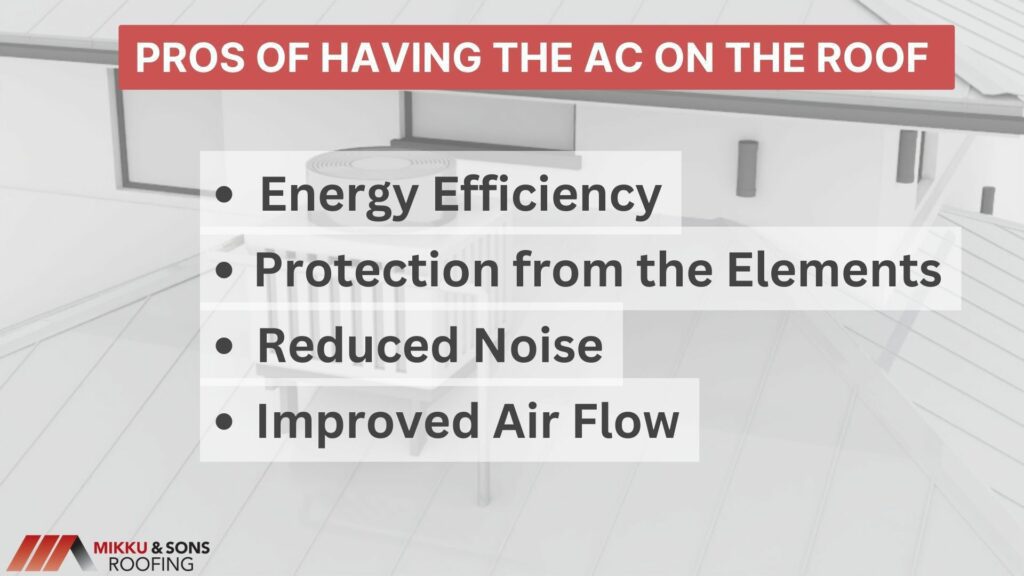
Hot, dry weather and high temperatures are typical of the state of Arizona, making it challenging to maintain a comfortable indoor environment throughout the summer. Installing an air conditioner (AC) on the roof is a popular method of reducing a building's inside temperature.
Arizona residents and company owners are increasingly leaning toward this option due to its potential advantages. Having an air conditioner on the roof in Arizona has several benefits, including the following:
Energy efficiency is a major benefit of a rooftop air conditioner. Installing the air conditioner on the roof allows for more efficient distribution of cooled air throughout the building, leading to lower cooling costs.
Over time, this may have a major impact on how much money you save on your energy expenses. Additionally, the rooftop AC unit can be strategically placed so that it is exposed to the maximum amount of sunlight, which can help to further reduce energy costs.
Putting an air conditioner up on the roof also has the added benefit of keeping it out of harm's way. Due to its high position, the unit is less prone to dirt and dust accumulation and severe weather.
In the long run, this may save money on repairs and maintenance and increase the lifespan of the device. In addition, insects and animals that attempt to enter the unit from the ground are less likely to do damage to it.
Putting an air conditioner on the roof is a great way to cut down on outside noise. The higher the apartment is located, the less probable it is that it will be heard from the rest of the building or the street below. Those with a low tolerance for noise or those who just prefer a peaceful environment at home or work would appreciate this feature.
Putting an air conditioner on the roof is one method for improving ventilation within a building. The placement of the unit may be planned such that the conditioned air is circulated thoroughly throughout the building.

Rooftop air conditioning units need regular maintenance to ensure continued operation. Keeping up with routine maintenance can keep your unit running well, saving you both money and energy.
Keeping an air conditioner in good working order begins with routine inspections. It is important to visually examine the exterior of the device for any evidence of corrosion, damage, or missing or loose components.
Moreover, make sure that all of the filters are clean and in excellent shape, as this will increase the efficiency of the unit. If problems are detected, it is recommended to have the device serviced by a qualified technician.
Cleaning the coils is the next step in maintaining a rooftop air conditioner. It's recommended to conduct this at least once a year, since dirt and debris may accumulate on the coils and cause the system to function less efficiently.
You may use a brush and some mild detergent to clean the coils. Before you begin cleaning the coils, make sure to cut off the electricity to the device.
Duct inspection is another important part of operating a rooftop air conditioner. Ducts need to be inspected for blockages and other damage. You should also look for mold or mildew in the ductwork, since this may have a negative impact on the performance of the HVAC system.
Having the filters changed often is also important. A dirty filter might decrease the effectiveness of the unit, hence it's recommended to change filters at least once a year. Furthermore, keeping the filters clean and changed out on a regular basis keeps the machine free from dust and other particles.
As a last step, be sure to always check the refrigerant levels. Low refrigerant levels might affect the efficiency of the device. However, the device itself might be damaged if the levels are not properly maintained.

Rooftop air conditioning (AC) units are a specific kind of air conditioning system that are mounted on the roof of a building. Commercial and industrial settings, such as offices, industries, schools, and hospitals, are popular locations for rooftop units. Size, efficiency, features, and installation all play a role in how much a rooftop AC unit will set you back.
Rooftop air conditioner prices are heavily influenced by the system's capacity. British thermal units are the standard for determining the size of the unit (BTUs). Larger units with greater BTU ratings cost more than smaller ones with lower ratings for the same purpose. In addition, the area of the room and the volume of air that has to be cooled should be determined before deciding on a unit so that the right size may be chosen.
A rooftop air conditioner's price might vary depending on how efficient it is. There will be a price premium for higher SEER-rated units compared to their lower-rated counterparts. Yet, high-efficiency units may be worth the initial investment if they help you save money on your monthly energy bills.
A rooftop air conditioner's price may also be affected by the unit's specific characteristics. Humidity regulators, thermostats, digital readouts, and other extras may come standard on certain models. The unit's performance and efficiency may benefit from these additions, but they come at an extra expense.
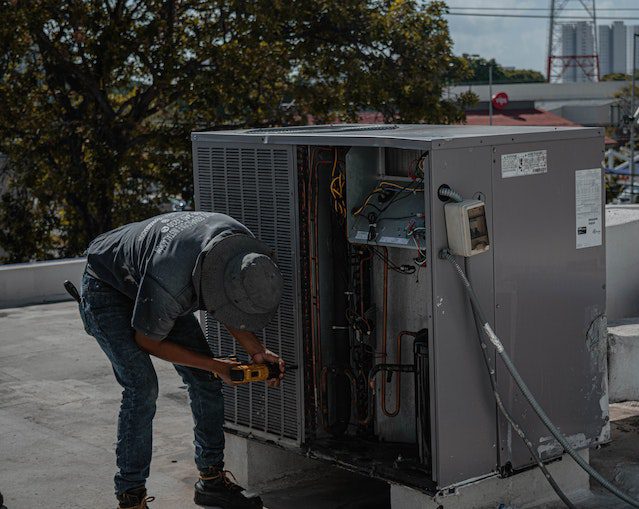
Next, you need to think about how much money it will cost to have an air conditioning unit put up on the roof. The price of installation might change based on factors including the size and complexity of the project, as well as the material used for the roof. Hiring a professional contractor is important for guaranteeing a thorough and secure installation of the unit.
Generally, small residential rooftop air conditioners can range in price from around $500 to $3,500 or more. Commercial rooftop air conditioners can range in price from around $1,500 to $20,000 or more.The final price tag for a rooftop air conditioner depends on many factors.
Common kinds of air conditioning systems in both business and residential structures include rooftop units and those installed in the ground. There are benefits and drawbacks to both options. Rooftop air conditioners are more expensive than ground-mounted units.
The total cost of purchasing, installing, and maintaining an air conditioner might vary widely. Air conditioners installed on a roof often cost more than those put in the ground. Putting the air conditioner on the roof adds more work time and material costs, so it's not a cheap option.
Rooftop installations often take longer than ground installations and need more work and supplies due to the difficulties of getting to the rooftop. The cost may also rise if the rooftop air conditioner has to be fortified against the weather.
Installing an air conditioner in the ground is often more cost-effective than on the roof. This is due to the reduced complexity and lower overall cost of installation. Moreover, ACs installed on the ground are more convenient to service and repair.
There seems to be an infinite number of ways to cool a house. The use of an air conditioner is a common choice. There are many different types of air conditioners on the market, but the two most common installations are on the roof or in a side yard. Both types of air conditioners have their benefits and drawbacks, and homeowners can make an informed choice by learning about both.
Designed specifically for installation on the roof of a building, rooftop air conditioners are typically larger than their side-yard counterparts. They are more expensive than window or wall units, but more cost-effective in the long run. Air conditioners installed on the roof are more effective at cooling large areas and generate less noise pollution than those installed on the ground. As they tend to be situated higher up and further away from the elements, they are also less vulnerable to weather conditions.
Air conditioners for the backyard are generally affordable and compact to those intended for rooftop installation. Apart from being easier to install and maintain, they also have a lower noise than rooftop AC units since they are closer to the ground, making them more susceptible to weather, and more exposed to noise pollution from nearby streets and buildings.
Despite being more compact, less expensive, and quieter, side-yard air conditioners may still contribute to unwanted noise pollution. The choice whether to install a rooftop or a side-yard AC unit should be made based on the square footage to be cooled, the homeowner's budget, and the threshold for noise pollution.
A wide range of climatic conditions, from hot and dry to cold and wet, can be found in Arizona. Therefore, Arizona homeowners ought to be familiar with the state's roofing regulations to protect themselves and their homes.
In this article, we'll examine the Arizona roofing license requirements so that you can get up to speed on the latest roofing laws and regulations.
We'll talk about the various roofing licenses out there, the requirements for getting one, and any other rules and regulations you need to know about. Let's get started with making sure you meet all the criteria for a roofing license in Arizona.
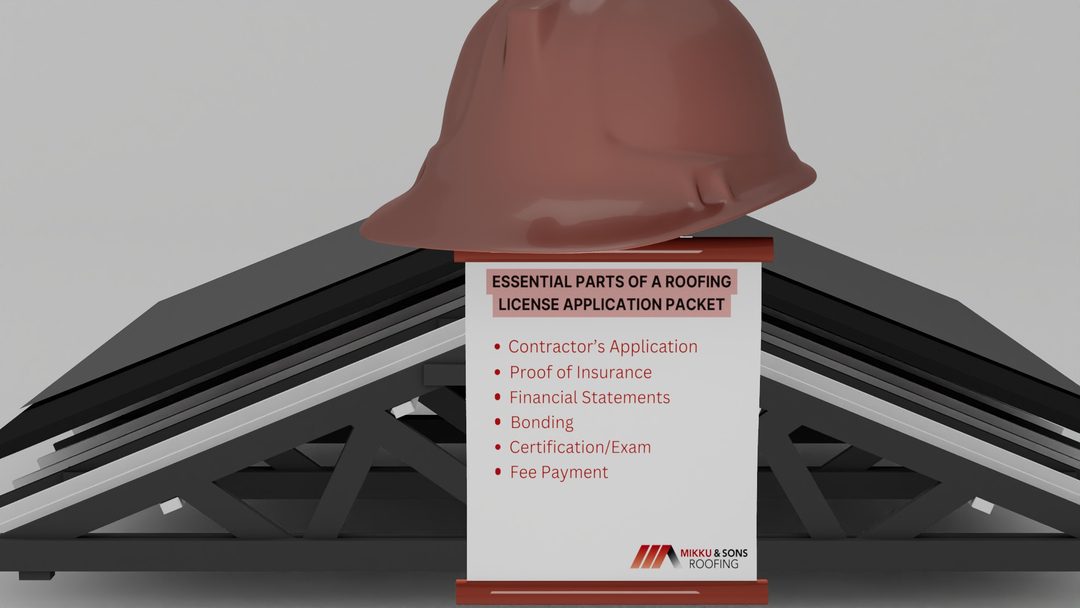
If you're a contractor looking to get your roofing license so you can start working on roofing projects, you need to fill out a roofing license application packet. A contractor's application, along with copies of any necessary documents and the appropriate fee, is usually required. What follows are the most crucial components of a roofing license application.
In order to get the contractor's name and contact information into the hands of the state licensing board, this form must be filled out. You can find the contractor's name, address, phone number, and license number on this document. Also included are the contractor's background and qualifications, as well as any disciplinary actions taken against them.
This certificate shows the licensing board that the contractor has purchased adequate liability insurance to pay for any damages that may arise as a result of the contractor's work. The policy's coverage levels must be at least as high as the state requirements.
The contractor's ability to pay taxes and other expenses is one factor the licensing board considers, so they need to see proof of financial stability in the form of tax returns, profit and loss statements, and balance sheets. With this information in hand, the board will be better able to determine whether or not the contractor has the resources necessary to finish the project.
Bonding is a way of providing the licensing board with assurance that the contractor will complete the job as promised. In the event that the contractor does not finish the job or does not fulfill the terms of the contract, the bonding company will provide financial compensation.
Getting a contractor's license in most states involves passing a certification exam. In most cases, the contractor will be tested on his or her knowledge of roofing techniques and safety procedures.
The licensing board requires all prospective contractors to submit an application fee. The cost can range from several hundred to several thousand dollars, depending on the state in which you live.
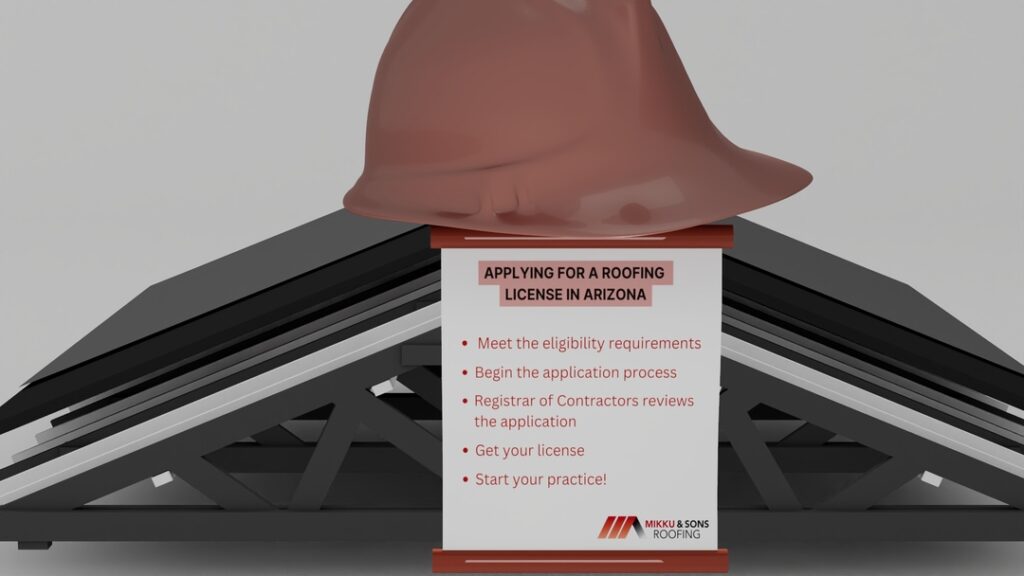
In Arizona, the steps necessary to apply for a roofing license are few and simple. It is necessary to fulfill the state's requirements before applying for a roofing contractor's license. Once that's done, you'll be able to get your license and begin working as soon as possible.
If you are a professional roofer looking to obtain a roofing license in Arizona, you need to meet the requirements set forth by the Arizona Registrar of Contractors (ROC). The process of obtaining a roofing license in Arizona involves completing an application and providing a surety bond.
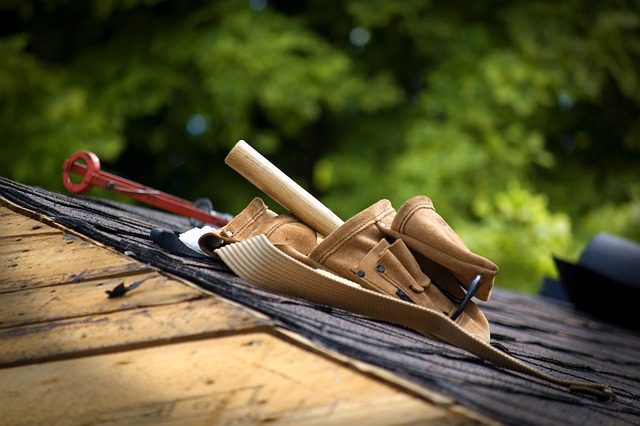
If you want to get a roofing license in Arizona, you’ll need to take the Arizona Roofers Exam. This exam is administered by the Arizona Registrar of Contractors (ROC) and is designed to ensure that roofers in the state have the knowledge and skills necessary to safely and effectively perform roofing work.
The Arizona Roofers Exam consists of two parts: a written exam and a practical exam. The written exam covers topics such as roofing materials, roofing systems, roofing installation, and roofing codes. You’ll need to answer multiple-choice, fill-in-the-blank, and true/false questions on the written exam. The practical exam requires you to demonstrate your skills in roofing installation, inspection, and repair.
In order to take the Arizona Roofers Exam, you’ll need to register with the Arizona Registrar of Contractors. You’ll need to provide proof of experience in roofing or related construction work, as well as proof of completion of the appropriate training courses. Once you’ve been approved to take the exam, you’ll need to schedule a testing appointment and pay the required fee.
Once you’ve passed both the written and practical exams, you’ll be issued a roofing license. This license is valid for four years, at which point you’ll need to renew it. You’ll also need to complete continuing education courses to maintain your license.
Getting a roofing license in Arizona is a major responsibility, and it’s important to make sure you have the knowledge and skills necessary to perform roofing work safely and effectively. If you’re considering becoming a roofer in Arizona, make sure you take the time to understand the requirements for getting a roofing license and take the necessary steps to become licensed.
In order to pass the Arizona Roofers Exam, it’s important to make sure you’re well-prepared. You can prepare for the written exam by studying the topics covered on the exam, such as roofing materials, roofing systems, roofing installation, and roofing codes. You can also find study guides and practice tests online to help you prepare for the exam.
For the practical exam, it’s important to make sure you have the necessary hands-on experience in roofing or related construction work. You can also take courses or workshops to help you learn the skills you’ll need to pass the exam.
Finally, make sure you take your time during the exam and read all of the questions carefully. If you’re not sure of the answer to a question, take your best guess and move on. Good luck!